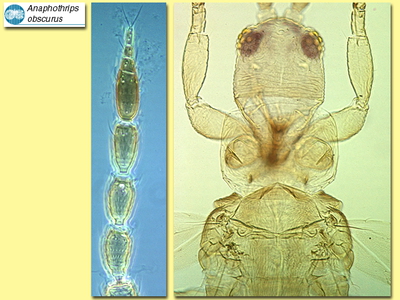Figures
Fig. 1 Antenna, head and pronotum
Fig. 2 Meso- and metanotum
Fig. 3 Fore and hind wing
Fig. 4 Tergite VIII and IX
Species
Anaphothrips obscurus Müller
Biology
Adults and larvae live only on members of the Gramineae, including cereal crops. In North America it is considered to be a pest on certain grasses where these are grown for seed production. It often lives protected within the leaf funnels, causing linear brown markings on developing leaves, or even causing these to die and wither as a white top. Females are dimorphic for wing development, but the male of the species remains unknown.
Distribution
Widely distributed in the temperate and sub-tropical regions of the world.
Recognition
Medium sized yellow thrips with light brown markings, distal antennal segments light brown. Often micropterous with forewings not reaching abdomen, but when fully macropterous the forewings are pale to very lightly shaded. Antennae 8-segmented, but segment VI subdivided by an oblique suture in apical third (producing an apparent 9-segmented condition). Metanotum and vertex of head weakly reticulate. Pronotum and forewings with no long setae. Tergite VIII posterior margin with a short comb of irregular microtrichia. Sternites without discal setae.
Related species
The genus Anaphothrips should probably be restricted to a group of about 30 species worldwide that live on grasses, but in Australia this genus is used for several unrelated species that lack any long setae on the pronotum. On grasses in warmer areas around the world, A. obscurus is replaced by a strongly bicoloured species, A. sudanensis.





